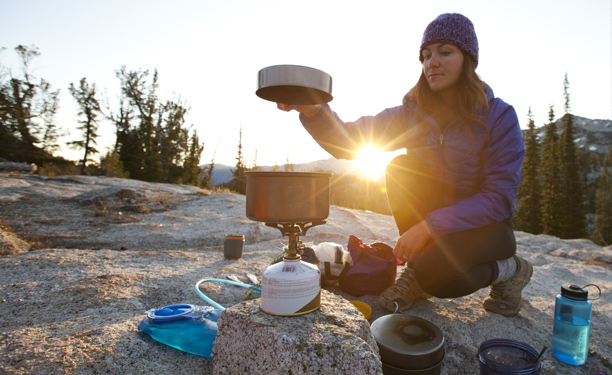Ultra Lightweight Cooking Systems
Posted by David A. on Mar 28th 2016

Written by David Ames, Bivouac Manager
When backpacking, space and weight are determinant in how your body performs and feels, both at the end of day and the beginning of the next one. Carrying bulky gear makes your hiking days more challenging than they otherwise need to be. When considering possible ways to drop weight from your gear, lightweight cooking systems and accessories present one of the more affordable options when compared with the cost of ultra light tents and high end sleeping bags . There are a few things we carry in the store that I have personally tried out in a variety of circumstances, so I’m going to take this opportunity to describe how these stoves and pots perform in different scenarios.
MSR Microrocket:
At 2.6 oz. and designed with three folding legs, the Microrocket is a favorite of lightweight enthusiasts. The stove comes with a Piezo starter in case you forget a lighter or matches, and it can boil 1 liter of water within 3.5 – 4.5 minutes, depending on the type of pot used and, of course, the weather conditions. This compact cooker is super versatile, and allows for control that ranges from a simmer to full power without losing fuel efficiency. It can work for car camping trips as well, depending how many people are being served. The burner features mini wind screens to improve the efficiency of the flame, however an extra wind screen could come in very handy in open areas where the wind is blowing more intensely. ALWAYS REMEMBER, HOWEVER, THAT SYSTEMS IN WHICH THE BURNER SITS DIRECTLY ABOVE THE FUEL SOURCE CAN CREATE AN EXTREMELY DANGEROUS SCENARIO WHEN PAIRED WITH ANY WINDSCREEN THAT FULLY SURROUNDS THE SYSTEM. Windscreens that attach to the system above the fuel source and only protect the burner and flame are safe to use. I will discuss a windscreen like this later in this blog post.
Olicamp: Vector Stove + XTS Pot
We’ll start with a look at the pot portion of this system, called the “XTS” (Xcelerator Transfer System). This fancy acronym simply means that a radiation rim on the bottom of the pot maximizes heat dispersion, directing all the heat towards the pot and reducing cooking time by 40%. Besides saving fuel and time, you are also saving some cash with this system compared to other similar mechanisms from Jetboil or even MSR’s Reactor cooking systems. One thing that I always found tricky about using ultra light stoves is stability. Yes, they are super packable, light, durable, efficient, etc. However, they often present a significantly smaller support area for your cooking pots/pans.
Optimus Clip on Windshield:
Lightweight, hard anodized aluminum increases stove efficiency and substantially reduces fuel consumption. It fits every gas canister according to EN417 and pots with max. diameter 13 cm (5 in). Compatible with standard pots and high profile heat stoves.
Sea to Summit: X Set 21
I wanted to leave this particular system for the end. This is because it is probably my personal favorite for its practicality. Usually the greatest concern for backpackers about cooking systems is the space it takes up in the backpack. Old school thru-hikers used to carry a regular 1L pot attached to the outside of the pack, leaving the interior of the pack for other, less bulky gear. However, the weight and bulk associated with this size system is no longer an issue. With the collapsible option that Sea to Summit offers with their X-line, you have the choice to take a 1.4L X Pot, X-Bowl (22 fl. oz.), and X-Mug (16 fl. oz.) for a total weight of 14oz. The pot itself combines the heat distribution and fast boil time of aluminum with the flexibility of silicone, the lid also works as a strainer. When it is time to wrap up the camp site, it will fold back down to an inch tall “disc”. If your hiking crew consists of more than just you, there is also the X-Set 31, with a 2.8L pot and a couple of bowls and mugs as well.
There are always new options, and brands are always trying to improve the efficiency, weight, size, and materials used in cooking systems. However, it is my opinion that this category of outdoor gear has changed the least over the years when compared with the way backpacks, hiking boots, and apparel have changed and improved decade after decade. Their transformation has been huge compared to cooking systems and technologies. The industry has certainly been working to come up with ways of making fuel efficiency better, and I’d say the next challenge/goal is to come up with less harmful materials to use when developing new products, especially related to the residues of metal left on food, how to make product more durable (in a sustainable manner), and also ensuring that these systems perform more consistently in wide range of elevations and conditions.
